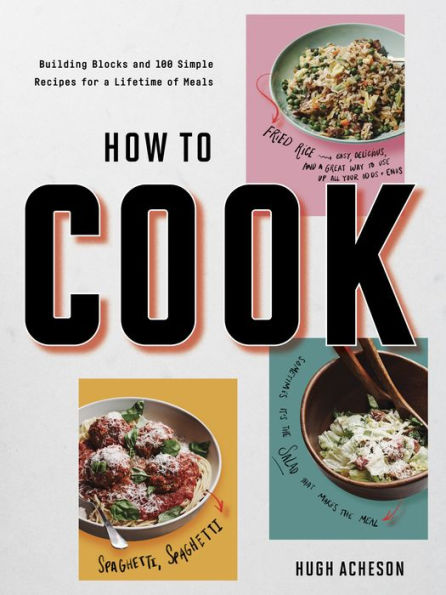
How to Cook: Building Blocks and 100 Simple Recipes for a Lifetime of Meals: A Cookbook
224
How to Cook: Building Blocks and 100 Simple Recipes for a Lifetime of Meals: A Cookbook
224Paperback
-
PICK UP IN STORECheck Availability at Nearby Stores
Available within 2 business hours
Related collections and offers
Overview
“A master class on nourishing yourself.”—The Atlanta Journal-Constitution
IACP AWARD WINNER • NAMED ONE OF THE BEST COOKBOOKS OF THE YEAR BY THE ATLANTA JOURNAL-CONSTITUTION AND WIRED
Acclaimed chef, TV star, and dedicated father Hugh Acheson taught his teenage daughters that cooking is an essential life skill. But he also knew that people don’t need to know how to cook like a chef to feed themselves and their friends. Really, they only need to learn a handful of skills to enjoy a lifetime of cooking.
So, in How to Cook, Hugh distills the cooking lessons that everyone should master into twenty-five basic building blocks: easy-to-grasp recipes that can turn anyone, young or old, into a confident home cook. Each of these recipes teaches a fundamental skill, such as roasting or whisking together a classic vinaigrette, and each stands alone as a stellar back-pocket basic. After laying the groundwork, How to Cook then offers recipes that expand on these foundations, whether it’s remixing the flavors of one of the basic recipes, or combining a couple of them, to show you how you can produce a lifetime’s worth of dishes.
How to Cook is the book Hugh is going to give his kids when they leave home, knowing that with these 100 recipes, they’ll be prepared to feed themselves for the rest of their lives.

Product Details
| ISBN-13: | 9780594197508 |
|---|---|
| Publisher: | Clarkson Potter/Ten Speed |
| Publication date: | 10/20/2020 |
| Pages: | 224 |
| Sales rank: | 1,082,352 |
| Product dimensions: | 7.30(w) x 10.00(h) x 0.70(d) |
About the Author

Read an Excerpt
What this book is all about
My daughters, Beatrice and Clementine, are well into their teens. I don’t think of myself as an overbearing parent, but I wrote that list for them sooner than I want to admit. Growing up the kids of a professional chef, they have been surrounded by good food their whole lives; when I think about them leaving home and living on their own, I want them to feel that they should still be surrounded by good food. I don’t expect them to cook like I do, but I do want to make sure they have the basics to be able to feed themselves, their friends, and eventually their own loved ones good, delicious, simple meals. And so I wrote this book, so that you can, too, whether you’re leaving home as a teenager, or making your own home, or starting your own family.
What follows is a really simple concept. There are a few ways to cook. One is to read recipes and stress about following them to the letter. Another is to dive into a kitchen and absorb everything, until you can make a bisque, brioche, or baked ziti without ever opening a cookbook.
What I think is the most approachable way to go about it is somewhere in the middle. There should be some very basic things that you know how to make almost from memory. I’m talking about a classic vinaigrette that you can use to dress salads, but also tweak to use as a sauce for roasted vegetables or meats or fish. Or how to cook pasta. Or a perfect grilled cheese, or how to roast a chicken or stir together a simple, flavor-packed herb sauce you can put on anything. Don’t worry, there are no tests; you don’t really have to memorize any recipes. But I want you to get comfortable making these very basic things, so that you can tweak them, add to or subtract from them, or mix and match them with stuff you have in your fridge, so you can make a meal anytime. Envision a Lego set of cooking skills; once you have those building blocks at hand, cooking becomes a skill you have forever.
So the first part of this book is dedicated to twenty-five building blocks that will anchor your world of cooking and give you the ability to build a system of nourishment. As a professional cook, I rely on core ideas of food to create dishes and menus, and there is no reason you shouldn’t do the same.
I’ve chosen the recipes for the building blocks not just because they’re great to make and eat and are flexible in how you use them, but also because in learning to make them, you will learn techniques you can apply to other foods. Learning how to sear a steak, for instance, will give you the same tools you need for searing pork chops or chicken breasts; roasting broccoli will teach you how to roast cauliflower or asparagus.
After those initial building blocks, there are seventy-five more recipes for you to use your new skills . . . or to use the leftovers of what you’ve already made. In fact, you might want to make some of the building blocks on a Saturday or Sunday afternoon and keep them in your fridgeto cook with through the week. I want you to think of leftovers not as “leftovers,” but as great ingredients that you can turn into new meals.
And with that, you’ll be able to cook anytime, forever.
Table of Contents
A List For A Future Generation 6
What This Book Is All About 7
What Is Good Food? 9
How You Should Shop 9
Complementary Flavors 11
Herbs, Spices, Salt + How To Use Them 15
What You Need In Your Kitchen 17
Using A Knife 18
The Building Blocks 20
Recipes 88
Acknowledgments 219
Index 220
